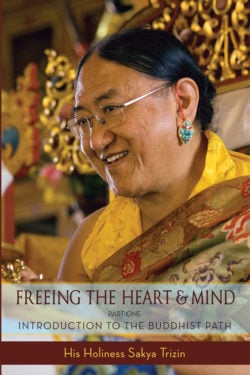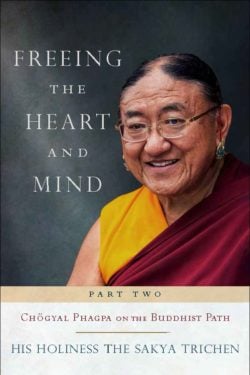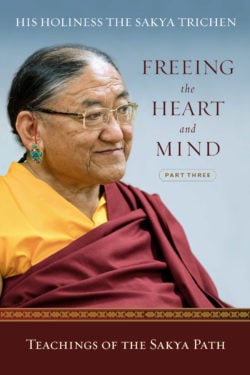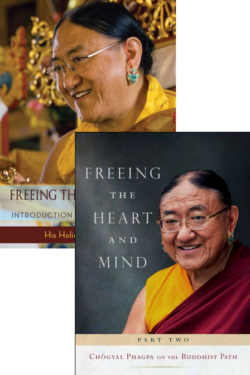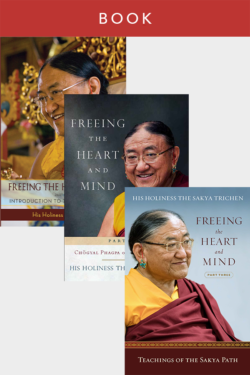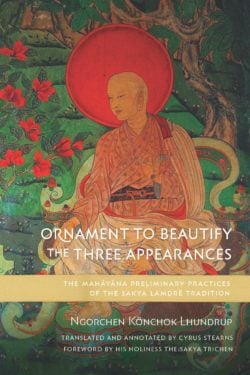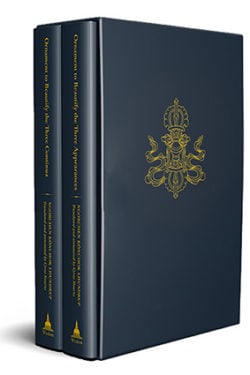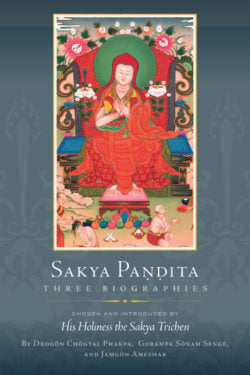His Holiness the Sakya Trichen
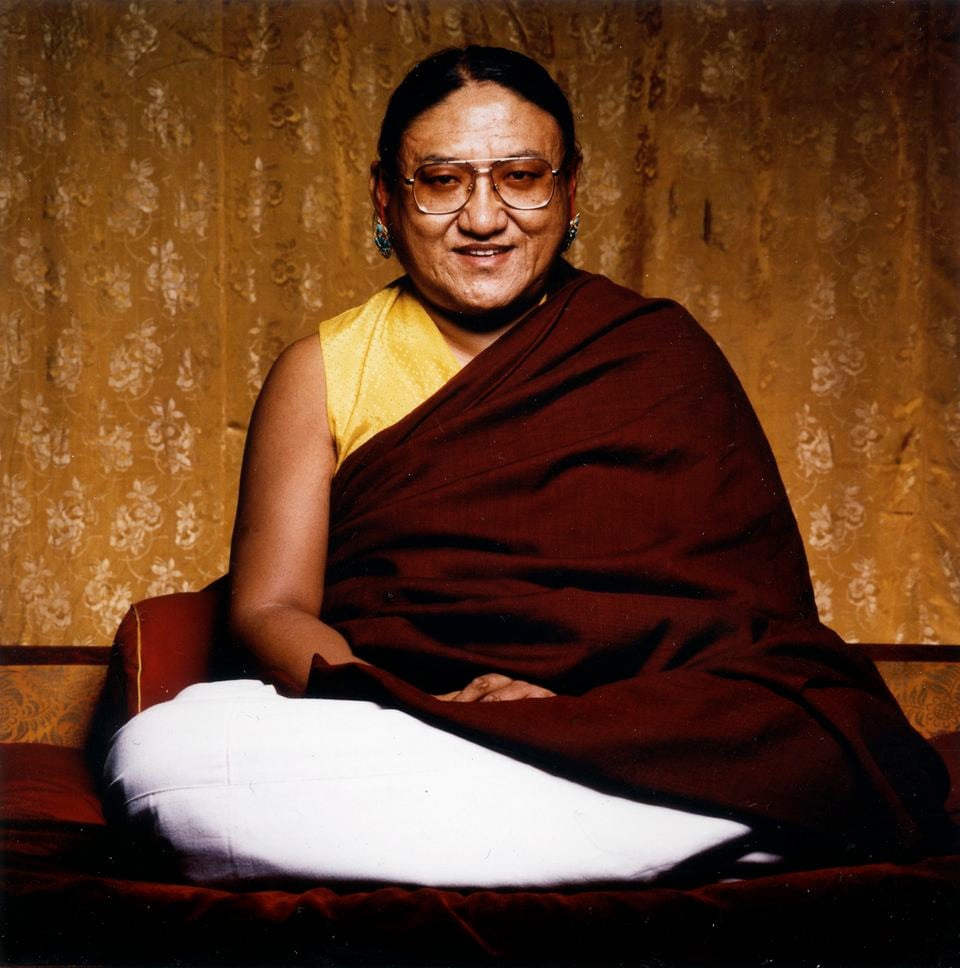
His Holiness the Sakya Trichen is the revered forty-first throne holder of the Sakya school of Tibetan Buddhism, which dates back to 1073. He is a member of the Khon family, who have been important teachers of Buddhism in Tibet since the eighth century. A brilliant master, he manifests profound wisdom and compassion, and his command of English renders his teachings particularly beneficial to students in the West. He was born in 1945 in Sakya, Tibet, and in 1959 escaped with tens of thousands of Tibetan people to India, where he continues to live and work tirelessly to rebuild the Sakya tradition. He has guided the establishment of over thirty monasteries in India and Nepal and has helped found Sakya centers around the world. His seat in North America is Tsechen Kunchab Ling in Walden, New York.
Books, Courses & Podcasts
Freeing the Heart and Mind
His Holiness the Sakya Trizin, the head of the glorious Sakya lineage, one of the four primary schools of Tibetan Buddhism, presents here the essential Buddhist teachings of the four noble truths, universal compassion, and the proper motivation for practice. This book opens by sharing a private teaching His Holiness gave to a young newcomer seeking to understand this great master’s spiritual heritage. His Holiness’s advice inspires us to integrate the living power of these teachings into our daily lives.
Full of timeless wisdom, Freeing the Heart and Mind contains, in addition to this introduction, an explanation of the teaching Matchless Compassion by the Indian saint Virupa, and a selection of commentaries on the essential teaching called Parting from the Four Attachments. Developed as the first volume in a course of study for students of the Sakya tradition, it nonetheless stands alone as an excellent entry into the teachings of the Buddha.
Freeing the Heart and Mind includes a full-color photo insert of Sakya lineage masters.
Freeing the Heart and Mind: Volume 2
His Holiness the Sakya Trichen, the forty-first head of the Sakya school of Tibetan Buddhism, with his trademark clarity and deep wisdom here unpacks two texts by the legendary thirteenth-century Drogön Chögyal Phagpa. A founding father of the Sakya school, Chögyal Phagpa became the first imperial preceptor under Kublai Khan and thus converted the Mongols to Tibetan Buddhism. His two texts presented here, A Gift of Dharma to Kublai Khan and A Garland of Jewels—the second of which was written as advice for Prince Gibek Timur—are marvels of insight.
Freeing the Heart and Mind includes a biography of Chögyal Phagpa by Ngawang Kunga Sönam, himself an important Sakya throneholder. A Gift of Dharma to Kublai Khan and A Garland of Jewels are then presented in sparkling translation, each accompanied by penetrating commentary from His Holiness. Freeing the Heart and Mind takes these two texts, written initially for royalty, and reveals how their timeless lessons—how to meditate, the personal characteristics we should cultivate, and the states on the path to buddhahood—can be incorporated into our lives today.
Featuring a gorgeous full-color photo section, this book can be enjoyed either as the second volume in the course developed by His Holiness or as a stand-alone volume on its own merits.
Read more about Freeing the Heart and Mind: Volume One here.
Freeing the Heart and Mind: Volume 3
Collected from teachings by His Holiness, this book is a warm and comprehensive introduction to the Buddhist path as told by the patriarch of the Sakya order. His Holiness offers explanations of the philosophical tenets of the Mahayana path and in particular the Sakya school of Tibetan Buddhism—giving down-to-earth advice for practicing in the world today, including
- the principles of tantra,
- the value of retreat,
- the history of the Sakya lineage,
- ecology from a Buddhist perspective,
- biographies of great women practitioners,
- and other fascinating topics.
This is a must-read for anyone interested in following a Buddhist spiritual path.
Freeing the Heart and Mind, Volumes 1 and 2
In Part One: Introduction to the Buddhist Path, His Holiness the Sakya Trichen—the head of the glorious Sakya lineage, one of the four primary schools of Tibetan Buddhism—presents the essential Buddhist teachings of the four noble truths, universal compassion, and the proper motivation for practice. This book opens by sharing a private teaching His Holiness gave to a young newcomer seeking to understand this great master’s spiritual heritage. His Holiness’ advice inspires us to integrate the living power of these teachings into our daily lives.
Part Two: Chogyal Phagpa on the Buddhist Path unpacks two texts by the legendary thirteenth-century Drogön Chögyal Phagpa. A founding father of the Sakya school, Chögyal Phagpa became the first imperial preceptor under Kublai Khan and thus converted the Mongols to Tibetan Buddhism. His two texts presented here, A Gift of Dharma to Kublai Khan and A Garland of Jewels, which was written as advice for Prince Gibek Timur, are marvels of insight.
Freeing the Heart and Mind, Part Two begins with a biography of Chögyal Phagpa by Ngawang Kunga Sönam, himself an important Sakya throneholder. The two texts are then presented in sparkling translation, each accompanied by penetrating commentary from His Holiness, who takes these texts, written initially for royalty, and shows how their timeless lessons—how to meditate, the personal characteristics we should cultivate, and the states on the path to buddhahood—can be incorporated into our lives today.
Taken together, these two books form an essential course developed by His Holiness the Sakya Trichen, showcasing his trademark clarity and deep wisdom.
The Freeing the Heart and Mind Trilogy
On the occasion of His Holiness the Sakya Trichen’s birthday (September 7), we wanted to take this opportunity to express our appreciation and respect for this beloved teacher. We’re also celebrating His Holiness’s birthday with a special offer: for the month of September 2020, you can get his full Freeing the Heart and Mind trilogy for just $29.95 (full value: $50.85) for the print editions or $19.99 for the ebook editions.
This trilogy is “required reading” for any Sakya practitioner, and will also be deeply inspiring for Buddhists of all traditions.
The series covers a wide range of teachings, including:
- In volume 1, an explanation of the teaching Matchless Compassion by the Indian saint Virupa, a selection of commentaries on the essential teaching called Parting from the Four Attachments.
- In volume 2, two texts by the legendary thirteenth-century Drogön Chögyal Phagpa. A founding father of the Sakya school, Chögyal Phagpa became the first imperial preceptor under Kublai Khan and thus converted the Mongols to Tibetan Buddhism. His two texts presented here, A Gift of Dharma to Kublai Khan and A Garland of Jewels—the second of which was written as advice for Prince Gibek Timur—are marvels of insight.
- And in volume 3, down-to-earth advice for practicing in the world today, including the principles of tantra, ecology from a Buddhist perspective, biographies of great women practitioners, and other fascinating topics.
We hope you’ll take advantage of this opportunity to be inspired by His Holiness’s teachings!
Ornament to Beautify the Three Appearances
Ornament to Beautify the Three Appearances is the first book of a two-volume set of works written by Ngorchen Könchok Lhundrup (1497–1557) to explain the Lamdré teachings, the most important system of tantric theory and practice in the Sakya tradition of Tibetan Buddhism. This volume is translated by Cyrus Stearns with a foreword by His Holiness the Sakya Trichen.
The Lamdré, or Path with the Result, is based on the Vajra Lines of the great Indian adept Virūpa (ca. seventh–eighth centuries). The first topic is the fundamental meditative practices of Hīnayāna and Mahāyāna Buddhism. In the Lamdré teachings, these preliminary instructions are known as the Three Appearances. The guiding instructions on impure appearance are for the purpose of developing renunciation. These focus on the defects of saṃsāra; the rarity, benefit, and transience of human life; and the nature of positive and negative actions and results. The guiding instructions on the appearance of the experiences are for the purpose of producing the altruistic intent. These focus on developing love, compassion, and bodhicitta and cultivating joy now about the uncommon experiences that will arise later when practicing the Vajrayāna teachings. The guiding instructions on pure appearance are for the purpose of producing enthusiasm for the ultimate result of complete awakening. These briefly describe the inconceivable nature of a buddha’s enlightened body, speech, and mind.
Having absorbed these preliminary instructions, the practitioner may go on to the second volume of Ngorchen’s works, a restricted text that explains the main tantric practices of the Three Continua, intended for students who have at least received the great initiation of Hevajra. Volume 2 is only available in a restricted box set that includes this first volume and can only be obtained on the Wisdom Publications website. Click here to learn more about the box set.
The Preliminary and Main Practices of the Sakya Lamdré Tradition
This beautiful box set contains translations of two major works written by Ngorchen Könchok Lhundrup (1497–1557) to explain the teachings of the Lamdré, or Path with the Result, the most precious system of tantric theory and practice in the Sakya tradition of Tibetan Buddhism. Both volumes are translated by Cyrus Stearns with a foreword by His Holiness the Sakya Trichen. The first volume is also available as a standalone book, and the teachings within it may be practiced by anyone, without specific, required preparation. Because the second volume explains Vajrayāna practices that require specific preparation, this is a restricted box set intended only for students who have at least received the great initiation of Hevajra.
The first volume, Ornament to Beautify the Three Appearances, explains the preliminary practices of the Lamdré. The guiding instructions on impure appearance are for the purpose of developing renunciation. These focus on the defects of saṃsāra; the rarity, benefit, and transience of human life; and the nature of positive and negative actions and results. The guiding instructions on the appearance of the experiences are for the purpose of producing the altruistic intent. These focus on developing love, compassion, and bodhicitta and cultivating joy now about the uncommon experiences that will arise later when practicing the Vajrayāna teachings. The guiding instructions on pure appearance are for the purpose of producing enthusiasm for the ultimate result of complete awakening. These briefly describe the inconceivable nature of a buddha’s enlightened body, speech, and mind.
The second volume, Ornament to Beautify the Three Continua, explains the main tantric practices of the Lamdré. To study, reflect, and meditate on these, a person must first receive the Hevajra initiation and keep the sacred commitments. Three main topics are presented: the cause, the path, and the ultimate result. To understand that the abiding mode of saṃsāra is not beyond the appearances of the mind, or the universal ground (since all the phenomena of saṃsāra and nirvāṇa are complete within the mind), the causal continuum of the universal ground is taught. To understand the essence of the path that is to be practiced, the precise way to meditate is taught. Moreover, to understand that the key points of the body must be targeted, the method continuum of the body is taught. To realize the essence of the result, the level of buddhahood is determined.
Dependent on the causal continuum of the universal ground, which is like a field, being purified by the method continuum of the body, which is like water and manure, the resultant continuum of mahāmudrā (the four resultant kāyas), which is like the ripened fruit, is actualized.
The first volume from this set may be purchased as a standalone volume here.
Sakya Paṇḍita
A set of classic biographies of Sakya Paṇḍita—one of Tibet’s greatest scholars and religious masters.
Sakya Paṇḍita Kunga Gyaltsen (1182–1251) was a renowned Tibetan polymath, scholar, statesman, and religious master, and one of the most famous and consequential figures in the history of Tibet. The three classic biographies included here contain fascinating firsthand accounts of key events in Sakya Paṇḍita’s life, covering his family ancestry, early education, interactions and debates with other sects, travels to Mongolia and his diplomacy at the Mongol court, and a detailed account of the miraculous events that occurred in the last weeks of his life.

